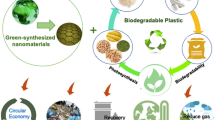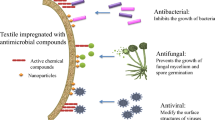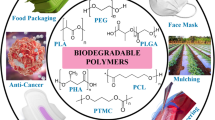Abstract
Silver-doped titania/polyurethane (nAg-TiO2/PU) nanocomposite coatings were synthesized through a combined solution combustion and grafting from polymerization method, where nanosilver-doped titania (nAg-TiO2) was chemically attached to the skeleton of the polyurethane polymer matrix with a bifunctional monomer, 2,2-bis(hydroxymethyl) propionic acid (DMPA). The polyester fabric functionalized with nAg-TiO2/polyurethane composites using dip-coating method has shown excellent antibacterial activity against gram-negative (Escherichia coli) and gram-positive (Staphylococcus epidermidis) bacteria. The nAg-TiO2 photoreduced under methanol vapor exhibited an improved bactericidal activity because of the formation of elemental silver instead of silver oxide. XRD-EDX analysis was conducted to elucidate the percent of silver doping, the crystalline structure of titania, and the coating pattern of nAg-TiO2/PU over polyester fabric. One percent silver-doped titania was considered optimum because of its higher bactericidal activity when compared with higher-percent silver-doped titania. Effective bactericidal activity has been observed under the black light illumination, which, in conjunction with Ag-TiO2, completely inhibits any bacterial growth within 3 h of exposure. Antimicrobial effect of coating of nAg-TiO2/PU on polyester fabric was retained even after 30 traditional textile washings.












Similar content being viewed by others
References
Brook, L. A., Evans, P., Foster, H. A., et al. (2007). Highly bioactive silver and silver/titania composite films grown by chemical vapour deposition. Journal of Photochemistry and Photobiology A, 187(1), 53–63.
Skorb, E. V., Antonouskaya, L. I., Belyasova, N. A., et al. (2008). Antibacterial activity of thin-film photocatalysts based on metal-modified TiO2 and TiO2:In2O3 nanocomposite. Applied Catalysis B, 84, 94–99.
Zhou, L. C., Li, Y. F., Bai, X., et al. (2009). Use of microorganisms immobilized on composite polyurethane foam to remove Cu(II) from aqueous solution. Journal of Hazardous Materials, 167, 1106–1113.
Zhang, X., Su, H., Zhao, Y., et al. (2008). Antimicrobial activities of hydrophilic polyurethane/titanium dioxide complex film under visible light irradiation. Journal of Photochemistry and Photobiology A, 199, 123–129.
Yagci, M. B., Bolca, S., Heuts, J. P. A., et al. (2011). Self-stratifying antimicrobial polyurethane coatings. Progress in Organic Coatings, 72(3), 305–314.
Zhao, L., Wang, H., Huo, K., et al. (2011). Antibacterial nano-structured titania coating incorporated with silver nanoparticles. Biomaterials, 32(24), 5706–5716.
Parkin, I. P., & Palgrave, R. G. (2005). Self-cleaning coatings. Journal of Materials Chemistry, 15, 1689–1695.
Shang, L., Li, B. J., Zheng, Y. Y., et al. (2010). Heteronanostructure of Ag nanoparticle on titanate nanowire membrane with enhanced photocatalytic properties. Journal of Hazardous Materials, 178, 1109–1114.
Lin, Y. C., & Lee, H. S. (2010). Effects of TiO2 coating dosage and operational parameters on a TiO2/Ag photocatalysis system for decolorizing Procion red MX-5B. Journal of Hazardous Materials, 179, 462–470.
Tryba, B., Pixzcz, M., Morawski, A. W. (2010). Photocatalytic self-cleaning properties of Ag-doped TiO2. Open Materials Science Journal, 4, 5–8.
Ye, X. Y., Zhou, Y. M., Chen, J., et al. (2007). Synthesis and infrared emissivity study of collagen-g-PMMA/Ag@TiO2 composite. Materials Chemistry and Physics, 106, 447–451.
Dastjerdi, R., Mojtahedi, M. R. M., Shoshtari, A. M., et al. (2010). Investigating the production and properties of Ag/TiO2/PP antibacterial nanocomposite filament yarns. Journal of the Textile Institute, 101, 204–213.
Samal, S. S., Jeyaraman, P., Vishwakarma, V. (2010). Sonochemical coating of Ag-TiO2 nanoparticles on textile fabrics for stain repellency and self-cleaning-the Indian scenario: a review. Journal of Minerals, Materials, Character, and Engineering, 9, 519–525.
Mills, A., & Hunte, S. L. (1997). An overview of semiconductor photocatalysis. Journal of Photochemistry and Photobiology A, 108, 1–35.
Burda, C., Chen, X., Narayan, R., et al. (2005). Chemistry and properties of nanocrystals of different shapes. Chemical Reviews, 105, 1025–1102.
Yu, J. G., Su, Y. R., Cheng, B. (2007). Template-free fabrication and enhanced photocatalytic activity of hierarchical macro-/mesoporous titania. Advanced Functional Materials, 17, 1984–1990.
Mills, A., Lepre, A., Elliott, N., et al. (2003). Characterisation of the photocatalyst Pilkington Activ (TM): a reference film photocatalyst. Journal of Photochemistry and Photobiology A, 160, 213–224.
Chin, P., & Ollis, D. F. (2007). Decolorization of organic dyes on Pilkington Activ™ photocatalytic glass. Catalysis Today, 123, 177–188.
Morones, J., Elechiguerra, J., Camacho, A., et al. (2005). The bactericidal effect of silver nanoparticles. Nanotechnology, 16, 2346–2353.
Nangmenyi, G., & Economy, J. (2008). Nanometallic particles for oligodynamic microbial disinfection. In N. Savage (Ed.), Nanotechnology applications for clean water (pp. 3–15). Norwich: William Andrew.
Cho, K. H., Park, J. E., Osaka, T., et al. (2005). The study of antimicrobial activity and preservative effects of nanosilver ingredient. Electrochimica Acta, 51(5), 956–960.
Sondi, I., & Salopek-Sondi, B. (2004). Silver nanoparticles as antimicrobial agent: a case study on E. coli as a model for gram-negative bacteria. Journal of Colloid and Interface Science, 275, 177–182.
Binyu, Y., Leung, K. M., et al. (2011). Synthesis of AG-TiO2 composite nano thin film for antimicrobial application. Nanotechnology, 22(115603), 1–9.
Kühna, K., Chabernya, I., Massholderb, K. (2003). Disinfection of surfaces by photocatalytic oxidation with titanium dioxide and UVA light. Chemosphere, 53(1), 71–77.
Fujishima, A., Hashimoto, K., Wuatanabe, T. (1999). TiO 2 photocatalysis fundamentals and applications (pp. 126–156). Tokyo: Bkc Inc.
Zhang, L. Z., Yu, J. C., Yip, H. Y., et al. (2003). Ambient light reduction strategy to synthesize silver nanoparticles and silver-coated TiO2 with enhanced photocatalytic and bactericidal activities. Langmuir, 19, 10372–10380.
Dong, W. J., Zhang, T. R., Epstein, J., et al. (2007). Multifunctional nanowire-bioscaffolds on titanium. Chemistry of Materials, 19, 4454–4459.
Dong, W. J., Shi, Z., Ma, J. J., et al. (2006). One-pot redox syntheses of heteronanostructures of Ag nanoparticles on MoO3 nanofibers. Journal of Physical Chemistry B, 110, 5845–5848.
Charpentier, P. A., Burgess, K., Wang, L., et al. (2012). Nano-TiO2/polyurethane composites for antibacterial and self-cleaning coatings. Nanotechnology. doi:10.1088/0957-4484/23/42/425606.
Petrella, A., Tamborra, M., Curri, M. L., et al. (2005). Colloidal TiO2 nanocrystals/MEH-PPV nanocomposites: photoelectrochemical study. Journal of Physical Chemistry B, 109, 1554–1562.
Kocher, M., Daubler, T. K., Harth, E., et al. (1998). Photoconductivity of an inorganic/organic composite containing dye-sensitized nanocrystalline titanium dioxide. Applied Physics Letters, 72, 650–652.
Khaled, S., Sui, R., Charpentier, P., et al. (2007). Synthesis of TiO2-PMMA nanocomposite: using methacrylic acid as a coupling agent. Langmuir, 23, 3988–3995.
Zan, L., Tian, L. H., Liu, Z. S., Peng, Z. H. (2004). A new polystyrene-TiO2 nanocomposite film and its photocatalytic degradation. Applied Catalysis, A264, 237–242.
Jordan, J., Jacob, K. I., Tannenbaum, R., et al. (2005). Experimental trends in polymer nanocomposites-a review. Materials Science and Engineering AA, 393, 1–11.
Mirabedini, S. M., Sabzi, M., Zohuriaan-Mehr, J., et al. (2001). Weathering performance of the polyurethane nanocomposite coatings containing silane treated TiO2 nanoparticles. Applied Surface Science, 257(9), 4196–4203.
Schaefer, D. W., & Justice, R. S. (2007). How nano are nanocomposites. Macromolecules, 40, 8501–8517.
Zan, L., Tian, L., Liu, Z., Peng, Z. (2004). A new polystyrene-TiO2 nanocomposite film and its photocatalytic degradation. Applied Catalysis, A264, 237–242.
Kim, S. H., Kwak, S. Y., Suzuki, T. (2006). Photocatalytic degradation of flexible PVC/TiO2 nanohybrid as an eco-friendly alternative to the current waste landfill and dioxin-emitting incineration of post-use. PVC Polymer, 47, 3005–3016.
Xia, H., & Wang, Q. (2002). Ultrasonic irradiation: a novel approach to prepare conductive polyaniline/nanocrystalline titanium oxide composites. Chemistry of Materials, 14, 2158–2165.
Li, C., Han, J., Ryu, C. Y., et al. (2006). A versatile method to prepare RAFT agent anchored substrates and the preparation of PMMA grafted nanoparticles. Macromolecules, 39, 3175–3183.
Wei, H., Ding, D., et al. (2013). Anticorrosive conductive polyurethane multiwalled carbon nanotube nanocomposites. Journal of Materials Chemistry A, 1, 10805–10813.
Zhu, J., Wei, S., et al. (2011). Electromagnetic field shielding polyurethane nanocomposites reinforced with core-shell Fe-silica nanoparticles. Journal of Physical Chemistry C, 115, 15304–15310.
Zhanhu, G., Lee, S. E., et al. (2009). Fabrication, characterization, and microwave properties of polyurethane nanocomposites reinforced with iron oxide and barium titanate nanoparticles. Acta Materialia, 57, 267–277.
Zhanhu, G., Sung, P., Thomas Hahn, H. (2007). Magnetic and electromagnetic evaluation of the magnetic nanoparticle filled polyurethane nanocomposites. Journal of Applied Physics, 10, 09M511.
Chattopadhyay, D., Prasad, P., Sreedhar, B., Raju, K. (2005). The phase mixing of moisture cured polyurethane-urea during cure. Progress in Organic Coatings, 54, 296–304.
Ni, H., Aaserud, D., Simonsick, W., Jr., et al. (2000). Preparation and characterization of alkoxysilane functionalized isocyanurates. Polymer, 41, 57–71.
Hojjati, B., Sui, R. H., Charpentier, P. A. (2007). Synthesis of TiO2/PAA nanocomposite by RAFT polymerization. Polymer, 48, 5850–5858.
Gouveia, I. C. (2010). Nanobiotechnology: a new strategy to develop non-toxic antimicrobial textiles for healthcare applications. Journal of Biotechnology, 150, 349–349.
Stephan Dubas, T., Kumlangdudsana, P., Potiyaraj, P. (2006). Layer-by-layer deposition of antimicrobial silver nanoparticles on textile fibers. Colloids and Surfaces A: Physicochemical and Engineering Aspects, 289(1), 105–109.
Reza Tehrani-Bagha, A., & Holmberg, K. (2013). Solubilization of hydrophobic dyes in surfactant solutions. Materials, 6, 580–608.
Matthew Henry (2010) New Technology Helps Medical Textiles Fight Hospital Germs. Medical Textiles. NanoHorizons Inc. pp 34–37
Mucha, H., Hoter, D., Swerev, M. (2002). Antimicrobial finishes and modifications. Melli Int, 8, 148–151.
Zhao, C., Feng, B., Li, Y., et al. (2013). Preparation and antibacterial activity of titanium nanotubes loaded with Ag nanoparticles in the dark and under the UV light. Applied Surface Science, 280, 8–14.
Chen, X. D., Wang, Z., Liao, Z. F., et al. (2007). Roles of anatase and rutile TiO2 nanoparticles in photooxidation of polyurethane. Polymer Testing, 26, 202–208.
Martin, R. B. (1996). Comparisons of indefinite self-association models. Chemical Reviews, 96, 3043–3064.
Wu, D., Long, M., Zhou, J., et al. (2009). Synthesis and characterization of self-cleaning cotton fabrics modified by TiO2 through facile approach. Surface and Coatings Technology, 203(24), 3728–3733.
DeCross, A. J., Marshall, B. J., McCallum, R. W., et al. (1993). Metronidazole susceptibility testing for heliobacter pylori: comparison of disk, broth, and agar dilution methods and their clinical relevence. Journal of Clinical Microbiology, 8, 31–31.
Thamaphat, K., Limsuwan, P., Ngotawornchai, B. (2008). Phase characterization of TiO2 powder by XRD and TEM. Journal of Natural Science, 42, 357–361.
Lok, C., Ho, C., Chen, R., et al. (2007). Silver nanoparticles: partial oxidation and antibacterial activities. Journal of Biological Inorganic Chemistry, 12(4), 527–534.
Radheshkumar, C., & Munstedt, H. (2006). Antimicrobial polymers from polypropylene/silver composites-Ag+release measured by anode stripping voltammetry. Reactive and Functional Polymers, 66, 780–788.
Solioz, M., & Odermatt, A. (1995). Copper and silver transport by CopB-ATPase in membrane vesicles of enterococcus hirae. Journal of Biological Chemistry, 270(16), 9217–9221.
Kawahara, K., Tsuruda, K., Morishita, M., et al. (2000). Antibacterial effect of silver-zeolite on oral bacteria under anaerobic conditions. Dental Materials, 16, 452–455.
Shrestha, R., & Raj Joshi, D. (2009). Oligodynamic action of silver, copper, and brass on enteric bacteria isolated from water of Kathmandu Valley. Nepal Journal of Science and Technology, 10, 189–193.
Acknowledgments
Financial support from National Science Foundation-Interdisciplinary Research Team and Materials Processing and Manufacturing (CMMI 10-30755) is kindly acknowledged.
Author information
Authors and Affiliations
Corresponding author
Rights and permissions
About this article
Cite this article
Sadu, R.B., Chen, D.H., Kucknoor, A.S. et al. Silver-Doped TiO2/Polyurethane Nanocomposites for Antibacterial Textile Coating. BioNanoSci. 4, 136–148 (2014). https://doi.org/10.1007/s12668-014-0125-x
Published:
Issue Date:
DOI: https://doi.org/10.1007/s12668-014-0125-x




